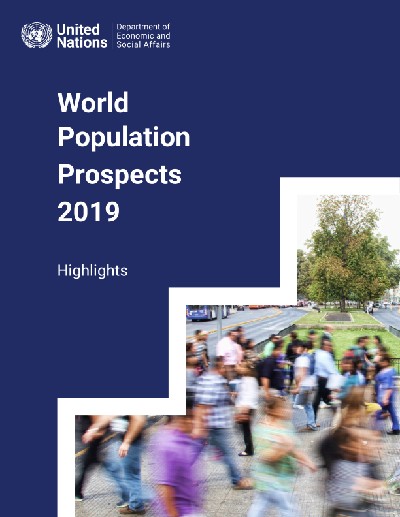"世界人口数据报告"相关数据
更新时间:2022-09-012019年世界人口展望
Understanding global population trends and anticipating the demographic changes to come are crucial to the achievement of the 2030Agenda for Sustainable Development. The 2030Agenda emphasizes that people are at the centre of sustainable development,echoing the ideals set forth in the Programme of Action of the International Conference on Population and Development adopted in Cairo in 1994.Population trends observed over the past few decades point to substantial progress made towards several of the Sustainable Development Goals (SDGs) so far.Examples include reduced mortality,particularly among children,as well as increased access to sexual and reproductive health care and enhanced gender equality that have empowered women to decide freely and responsibly the number,spacing and timing of their children.
Recent demographic trends are harbingers of the future challenges to sustainable development. For example,countries experiencing rapid population growth,most of which are in sub-Saharan Africa,must provide schooling and health care to growing numbers of children,and ensure education and employment opportunities to increasing numbers of youth. Countries where population growth has slowed or stopped must prepare for an increasing proportion of older persons and, in some cases,decreasing population size. These and other challenges can be addressed in part by anticipating coming demographic trends and incorporating that information into policies and planning.
The United Nations population estimates and projections form a comprehensive set of demographic data to assess population trends at the global, regional and national levels. They are used in the calculation of many of the key development indicators commonly used by the United Nations system,including for more than one third of the indicators used to monitor progress towards the achievement of the sDGs. The 2019 revision of the World Population Prospects is the twenty-sixth edition of the United Nations population estimate sand projections,which have been prepared since1951 by the Population Division of the Department of Economic and Social Affairs.The 2019 revision presents population estimates from 1950 until the present for 235 countries or areas, which have been developed through country-specific analyses of historical demographic trends. It builds on previous revisions by incorporating additional results from the 2010 and 2020 rounds of national population censuses as well as information from vital registration and recent nationally representative household surveys.The 2019 revision also presents population projections to the year 2100 that reflect a range of plausible outcomes at the global, regional and country levels.
【更多详情,请下载:2019年世界人口展望】

 1950-2015年全球241个国家和地区总人口数各个年龄段的年度总人口(两性合计)。1950-2015年发布时间:2020-07-01
1950-2015年全球241个国家和地区总人口数各个年龄段的年度总人口(两性合计)。1950-2015年发布时间:2020-07-01 2015-2100年全球242个国家和地区5岁以下的人口数人口数据基于2015年至2100年联合国中型预测(2017年版)2015-2100年发布时间:2020-07-21
2015-2100年全球242个国家和地区5岁以下的人口数人口数据基于2015年至2100年联合国中型预测(2017年版)2015-2100年发布时间:2020-07-21 1950-2015年全球241个国家和地区人口数量的变化年度人口统计指标。1950-2015年发布时间:2020-07-01
1950-2015年全球241个国家和地区人口数量的变化年度人口统计指标。1950-2015年发布时间:2020-07-01 1950-2015年全球241个国家和地区女性总人口数按年龄分的年度人口-女性。截至当年7月1日的实际人口按单身年龄分类(0、1、2,...,99、100+)。数据以千为单位。1950-2015年发布时间:2020-07-01
1950-2015年全球241个国家和地区女性总人口数按年龄分的年度人口-女性。截至当年7月1日的实际人口按单身年龄分类(0、1、2,...,99、100+)。数据以千为单位。1950-2015年发布时间:2020-07-01 1950-2015年全球241个国家和地区男性总人口数按年龄分的年度人口-男性。截至当年7月1日的实际人口按单身年龄分类(0、1、2,...,99、100+)。数据以千为单位。1950-2015年发布时间:2020-07-01
1950-2015年全球241个国家和地区男性总人口数按年龄分的年度人口-男性。截至当年7月1日的实际人口按单身年龄分类(0、1、2,...,99、100+)。数据以千为单位。1950-2015年发布时间:2020-07-01 1500-2000年全球190个国家世界各个国家人口数量原始数据发布的单位为千人,本数据在原始数据上已乘以10001500-2000年发布时间:2020-07-13
1500-2000年全球190个国家世界各个国家人口数量原始数据发布的单位为千人,本数据在原始数据上已乘以10001500-2000年发布时间:2020-07-13 2015-2100年全球242个国家和地区按联合国中位数预测的25-64岁人口数2017年版的人口数据基于2015年至2100年的联合国中位数预测。2015-2100年发布时间:2020-06-09
2015-2100年全球242个国家和地区按联合国中位数预测的25-64岁人口数2017年版的人口数据基于2015年至2100年的联合国中位数预测。2015-2100年发布时间:2020-06-09 2015-2100年全球242个国家和地区按联合国中位数预测的6-11岁人口数2017年版的人口数据基于2015年至2100年的联合国中位数预测。2015-2100年发布时间:2020-06-09
2015-2100年全球242个国家和地区按联合国中位数预测的6-11岁人口数2017年版的人口数据基于2015年至2100年的联合国中位数预测。2015-2100年发布时间:2020-06-09 2015-2100年全球242个国家和地区按联合国中位数预测的65岁以上人口数2017年版的人口数据基于2015年至2100年的联合国中位数预测。2015-2100年发布时间:2020-06-09
2015-2100年全球242个国家和地区按联合国中位数预测的65岁以上人口数2017年版的人口数据基于2015年至2100年的联合国中位数预测。2015-2100年发布时间:2020-06-09 2015-2100年全球242个国家和地区按联合国中位数预测的12-24岁人口数2017年版的人口数据基于2015年至2100年的联合国中位数预测。根据联合国“ 12-14”岁和“ 15-24”岁年龄段的总和得出了“ 12-24岁”年龄类别的人口。2015-2100年发布时间:2020-06-06
2015-2100年全球242个国家和地区按联合国中位数预测的12-24岁人口数2017年版的人口数据基于2015年至2100年的联合国中位数预测。根据联合国“ 12-14”岁和“ 15-24”岁年龄段的总和得出了“ 12-24岁”年龄类别的人口。2015-2100年发布时间:2020-06-06 2015-2100年全球241个国家和地区根据生育率中位数计算的人口数量各个年龄段的年度总人口统计。数据以千为单位。2015-2100年发布时间:2020-07-09
2015-2100年全球241个国家和地区根据生育率中位数计算的人口数量各个年龄段的年度总人口统计。数据以千为单位。2015-2100年发布时间:2020-07-09 2015-2100年全球241个国家和地区根据生育率中位数计算的65岁或以上的人口数量各个年龄段的年度总人口统计。数据以千为单位。2015-2100年发布时间:2020-07-09
2015-2100年全球241个国家和地区根据生育率中位数计算的65岁或以上的人口数量各个年龄段的年度总人口统计。数据以千为单位。2015-2100年发布时间:2020-07-09 2015-2100年全球241个国家和地区根据生育率中位数计算的5岁以下的人口数量各个年龄段的年度总人口统计。数据以千为单位。2015-2100年发布时间:2020-07-09
2015-2100年全球241个国家和地区根据生育率中位数计算的5岁以下的人口数量各个年龄段的年度总人口统计。数据以千为单位。2015-2100年发布时间:2020-07-09 2015-2100年全球241个国家和地区根据生育率中位数计算的25岁以下的人口数量各个年龄段的年度总人口统计。数据以千为单位。2015-2100年发布时间:2020-07-09
2015-2100年全球241个国家和地区根据生育率中位数计算的25岁以下的人口数量各个年龄段的年度总人口统计。数据以千为单位。2015-2100年发布时间:2020-07-09 2015-2100年全球241个国家和地区根据生育率中位数计算的15岁以下的人口数量各个年龄段的年度总人口统计。数据以千为单位。2015-2100年发布时间:2020-07-09
2015-2100年全球241个国家和地区根据生育率中位数计算的15岁以下的人口数量各个年龄段的年度总人口统计。数据以千为单位。2015-2100年发布时间:2020-07-09 2015-2100年全球241个国家和地区根据生育率中位数计算的25-64岁的人口数量各个年龄段的年度总人口统计。数据以千为单位。2015-2100年发布时间:2020-07-09
2015-2100年全球241个国家和地区根据生育率中位数计算的25-64岁的人口数量各个年龄段的年度总人口统计。数据以千为单位。2015-2100年发布时间:2020-07-09 2015-2100年全球241个国家和地区根据生育率中位数计算的15-64岁的人口数量各个年龄段的年度总人口统计。数据以千为单位。2015-2100年发布时间:2020-07-09
2015-2100年全球241个国家和地区根据生育率中位数计算的15-64岁的人口数量各个年龄段的年度总人口统计。数据以千为单位。2015-2100年发布时间:2020-07-09 1950-2017年全球7个大洲和地区人口数量每年根据各种来源的普查数据,调查,生命登记和行政记录对人口数据进行报告。 人口被记录为“事实上的”,这意味着人口包括在参考日期该国实际居住的所有人员,无论他们是普通居民还是合法居民。1950-2017年发布时间:2020-07-13
1950-2017年全球7个大洲和地区人口数量每年根据各种来源的普查数据,调查,生命登记和行政记录对人口数据进行报告。 人口被记录为“事实上的”,这意味着人口包括在参考日期该国实际居住的所有人员,无论他们是普通居民还是合法居民。1950-2017年发布时间:2020-07-13 1980-2015年全球一岁儿童的人口数量该数据包含了1980-2015年全球一岁儿童的人口数量。2015年世界总计为135721024人。1980-2015年发布时间:2020-07-10
1980-2015年全球一岁儿童的人口数量该数据包含了1980-2015年全球一岁儿童的人口数量。2015年世界总计为135721024人。1980-2015年发布时间:2020-07-10 1790-2010年美国城镇人口数当美国人口普查局在1880年和1890年的人口普查中首次定义城市场所时,城市场所就是至少有4,000至8,000人的城市场所。 此门槛在1910年的人口普查中上升到2500人,到1950年的人口普查又上升到50,000以上。1790-2010年发布时间:2020-07-21
1790-2010年美国城镇人口数当美国人口普查局在1880年和1890年的人口普查中首次定义城市场所时,城市场所就是至少有4,000至8,000人的城市场所。 此门槛在1910年的人口普查中上升到2500人,到1950年的人口普查又上升到50,000以上。1790-2010年发布时间:2020-07-21





